Best Running Headphones 2022 | Live Science

Leave silent training sessions behind you by picking up a pair of the best running headphones — it might just improve your performance. Studies (like this one published in the Journal of Human Sport and Exercise (opens in new tab)) suggest the right soundtrack can increase your speed and lessen mental fatigue when running. So, if you want to shave seconds off your 5K PB, adding some running headphones to your race-day arsenal may be the way to go.
But what sets these earbuds apart from standard cans? The best running headphones will be sweatproof and robust, offering a secure fit so you don’t have to worry about them tumbling to the floor when lacing up your running shoes. Premium sound quality with a powerful bass to help you push the pace is a prerequisite, and if you’re an endurance athlete or marathon runner-in-training you’ll also need them to remain comfortable during longer sessions.
Below, our fitness writers have picked a selection of their favourite running headphones that tick every box, offering a great fit, solid build and sumptuous sound. We’ve also put several top models to the test, from the illustrious PowerBeats Pro to the sleek-yet-affordable Mifo O5 Plus (opens in new tab), putting them through a rigorous trial process to bring you a series of honest reviews.
So, if you’ve been keeping your ear to the ground for a great running headphone deal, look no further. Read on to find out which pairs have the acumen to take your training to new heights, and blare that playlist proudly as you push through the hard miles.
Best running headphones 2022
The Pro’s predecessor, the JBL Reflect Flow headphones, were widely adored for their solid sound quality, brilliant fit and value for money. Fortunately, we found their successor only improves upon their already impressive performance.
They have an upgraded IP68 rating for dust and water resistance meaning that, while they’re not intended for swimming, they can hold up through the most treacherous of trail runs. They have also added in adaptive noise canceling, so you can choose between total noise cancellation, ambient aware or “talk thru” modes to decide how much external sound you want to hear. This is great if you want to focus on your run without distractions, or allow the atmosphere of a race day crowd in while running to your favorite tunes. We found the active noise canceling was good, though it didn’t quite hit the empty room-esque heights of the Soundcore buds (read more about these below).
When it came to sound quality, we were impressed again. Rather than the bass-heavy sound that so many sports headphones default to, the JBL Reflect Flow Pros provided a pleasing level of balance and detail.
However, where these headphones really excel is the fit. They come with a selection of three interchangeable silicone tips and four silicone “powerfins” that sit against the inside of the ear, so you can find the right size for you (something you can check through the clever “check my best fit” feature on the app). And, after using this handy feature, we found the earbuds stayed perfectly in place throughout an intense sprint session and a HIIT workout.
The powerfins are quite rigid meaning we found our ears could begin to ache during longer wears, but for those who prefer running fast and tackling intense exercise sessions like HIIT, we think the JBL Reflect Flow Pros excellent fit and sound make them a top option.
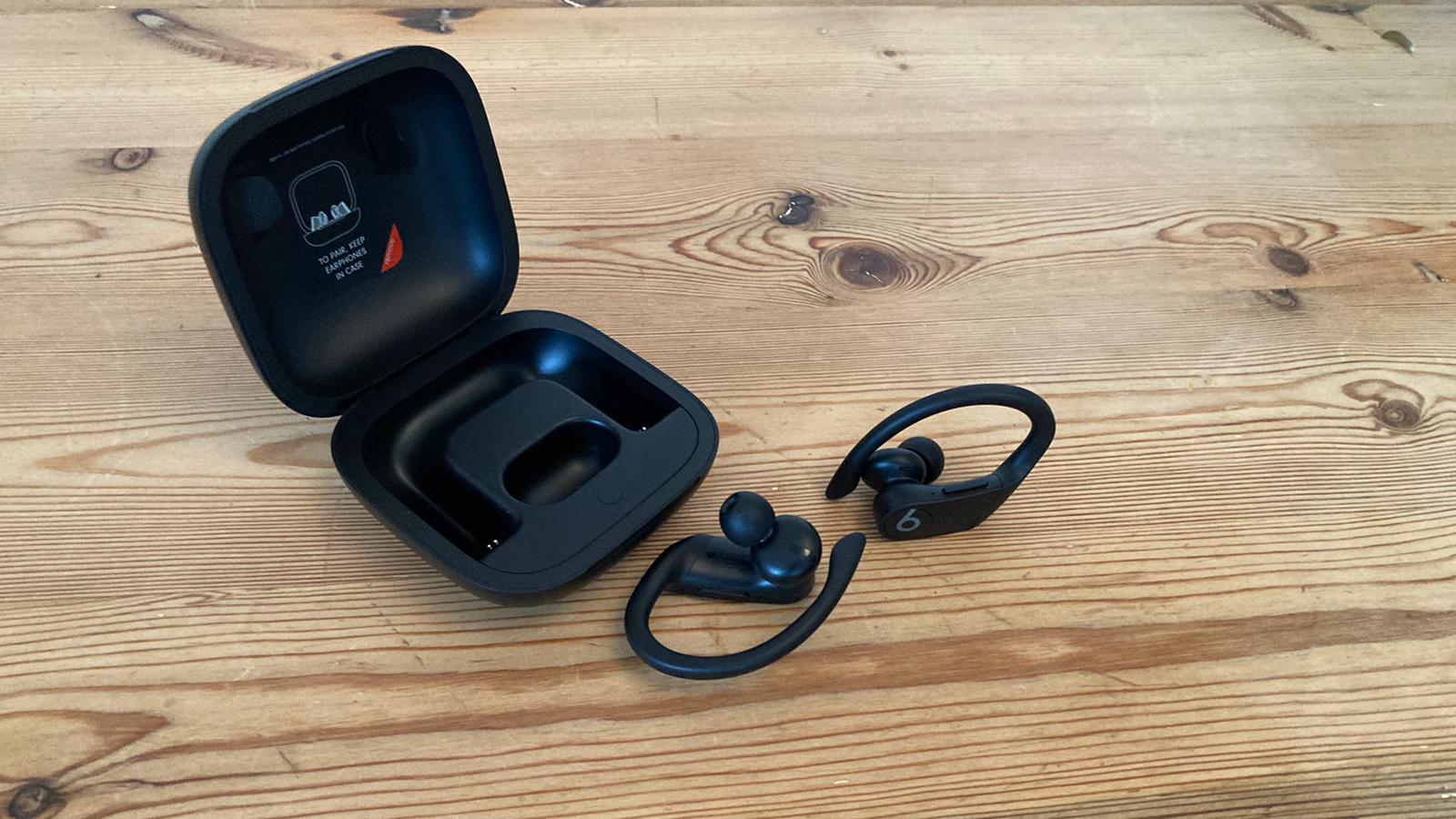
When Apple dropped the first AirPods in 2016 (thrusting true wireless headphones into the limelight in the process) many feared the tiny tech would tumble from their ears, never to be seen again. Fortunately, with the PowerBeats Pro, there’s no risk of this.
They have plastic hooks that sit snug around the ear to keep the earbuds in place. These are slightly malleable, so you can push them into position to ensure a slightly customized fit. When you combine these hooks with a selection of silicone tips designed to offer a secure seal, you’re left with a foolproof, comfortable fit.
For this reason, along with their nine-hour battery life on a single charge, we think these would marry well with endurance athletes or marathon runners-in-the-making. After all, if you’re going to hit the 26.2 mile mark, the last thing you need is your headphones failing you or causing any additional discomfort.
We also liked the inclusion of buttons (a volume rocker and action buttons on either earbud) rather than touch controls. We found these were easier to use while on the move, and were less likely to be triggered when accidentally brushed by a sweat-mopping forearm.
There is one big omission from the PowerBeats Pro though: ANC. Given these are Apple’s premier sports earbuds, it’s a feature we would have expected to see, but the solid seal offered by the silicone earbuds and the 12mm driver size means you still enjoy good quality audio. Acoustics aficionados may also want a more powerful sound, but they still offer a better listening experience than most headphones.
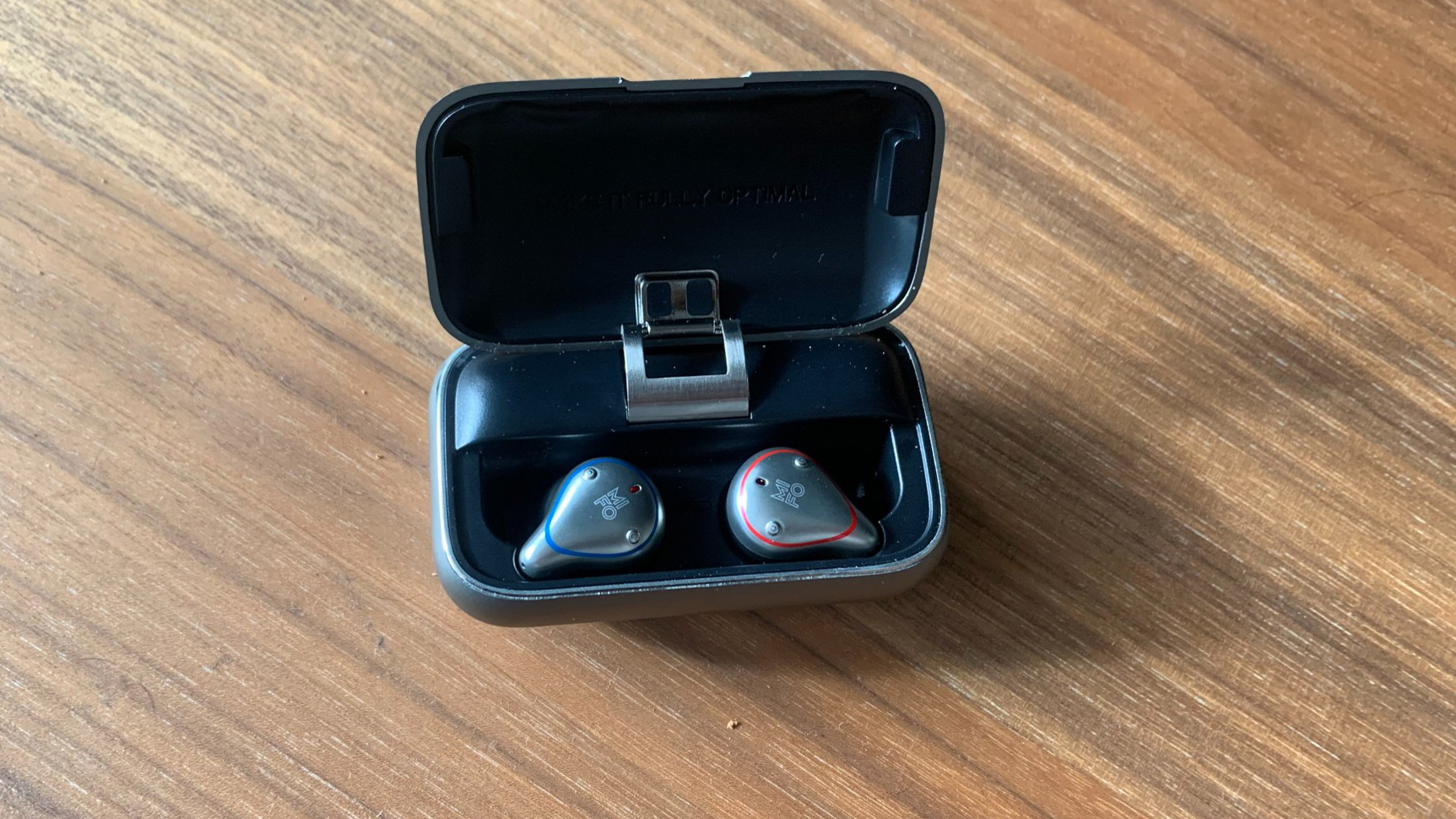
Tracking down a top pair of running headphones for under $100 can be a more arduous task than a 10K with a pebble in your shoe, but we think we’ve cracked it.
The sleek Mifo O5 Plus Gen 2 earbuds look like something out of James Bond’s box of tricks, and they’re incredibly comfortable too. With a choice of seven sizes of silicone bud, you’re sure to find a set to provide a good seal (which, instead of ANC, provides passive noise canceling). We found we were able to run, jump, burpee and box jump to our heart’s content without them coming loose. What’s more, their impressive IPX7 waterproof rating means they’ll easily survive the heaviest of downpours.
Their battery life is impressive. The earbuds alone will do seven hours on a single charge, which is a solid performance by most true wireless headphones’ standards. But when the metallic portable charging case is brought into consideration this figure flies up to over 100 hours. Pair this with the fact that you can charge them up in just 20 minutes and you’ve got a whole lot of playback time before you have to seek out a mains outlet again.
The sound quality may not meet dedicated audiophiles’ expectations, as we found it was good without venturing into the mind blowing realms of the Bose and Soundcore sets. But they were incredibly comfortable for longer wears — something we think makes them a good fit for trail runners after a hardy, long-lasting and secure pair of headphones.

The Amazfit PowerBuds Pro earbuds surprised us; we weren’t expecting heart rate monitoring capabilities from our headphones. Amazfit has thrown the kitchen sink at this model, ergonomically designing their earbuds to seal to the wearer’s ear and deliver thudding bass and precision sound, along with a wealth of health and tracking features via their partner app.
We tested this model across several workouts, including high and low-intensity exercises to see how they fared. Four ear tips promise to help secure a reliable fit, but we struggled to find ones that held the PowerBuds in and wouldn’t recommend them during rigorous exercises like sprinting.
Four intelligent ANC (noise cancellation) settings tailor to your environment, helping to filter unwanted distractions while retaining important audio like announcements and traffic to keep you safe without ruining your music experience. Transparency mode filters exterior sound back to your ears so you can chat with mates while you move.
These earphones house multiple mics and a heart rate sensor to deliver real-time heart rate feedback. You can sync workout stats to your app, including metrics on distance and calories, and modify your earbud’s touch control settings in-app, too. Advanced features allow you to set alerts for high resting heart rate detection and posture, sending music to your earbuds to encourage you to move. These buds deliver on sound and extra tech.
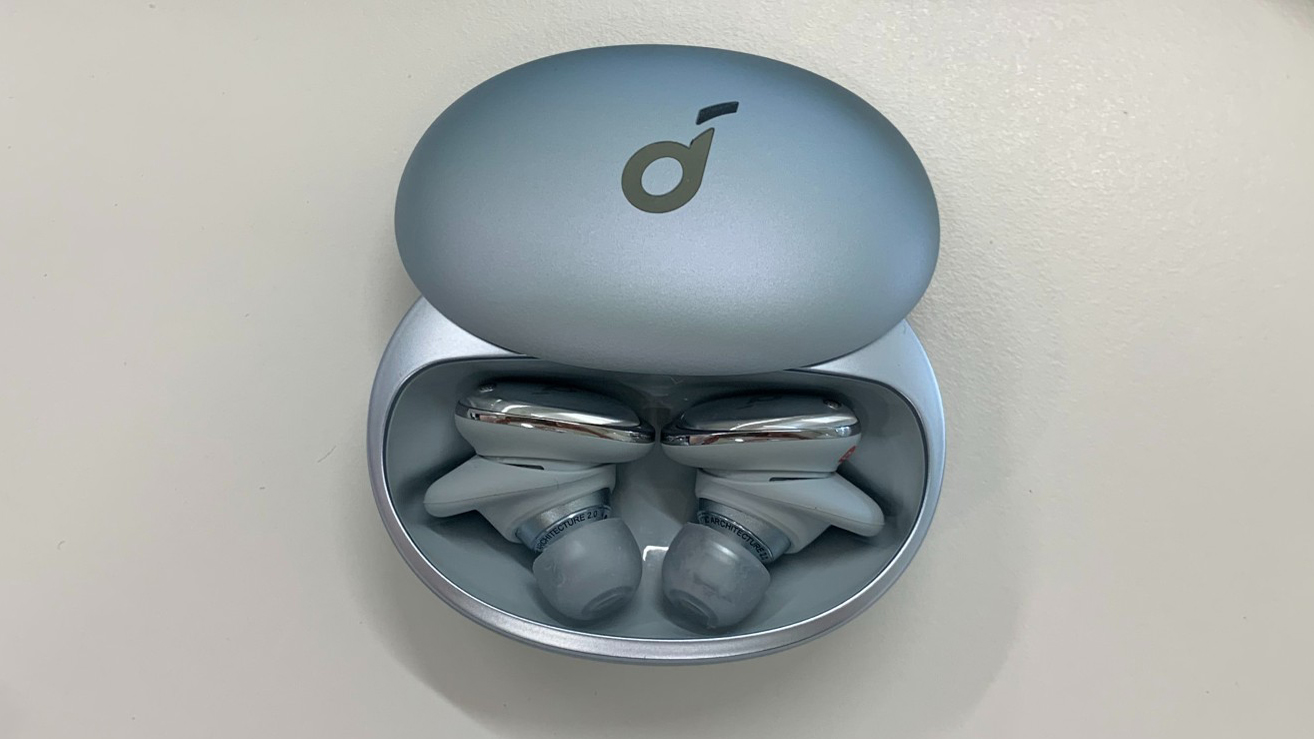
The Soundcore Liberty 3 headphones deliver brilliant sound without breaking the bank. So, true musos searching for a set of earbuds that won’t do their favorite playlists a disservice are in luck. You can customize your sound in the Soundcore app too, tinkering with the EQ to suit different genres or popping them into a “professional mode” which has been designed by Grammy-winning producers.
They have 3D surround sound and remarkably efficient HearID noise cancellation (ANC) too, so you can block out distractions if you want to zone in on your performance. We’d recommend switching to transparency mode (which lets in some external sound) if you’re running near roads though, as it really is effective.
But, one downside we did come across was that the fit isn’t as secure as many of their competitors. They come with a choice of four different silicone tips and wings so you can find the right size to provide your ears with a good seal, and we found these worked well to keep them in place during low impact workouts like weight training and yoga. But even with these we found they would come loose or wobble during fast-paced runs and other higher impact activities.
So, if you want some earbuds to soundtrack your sprint sessions, this Soundcore Liberty 3 Pro pair probably isn’t for you. However, if you’re a music-lover looking for a set of headphones for everyday wear, or to use exclusively for slower-paced runs and less intense exercise, then you’ll relish their fantastic sound quality.
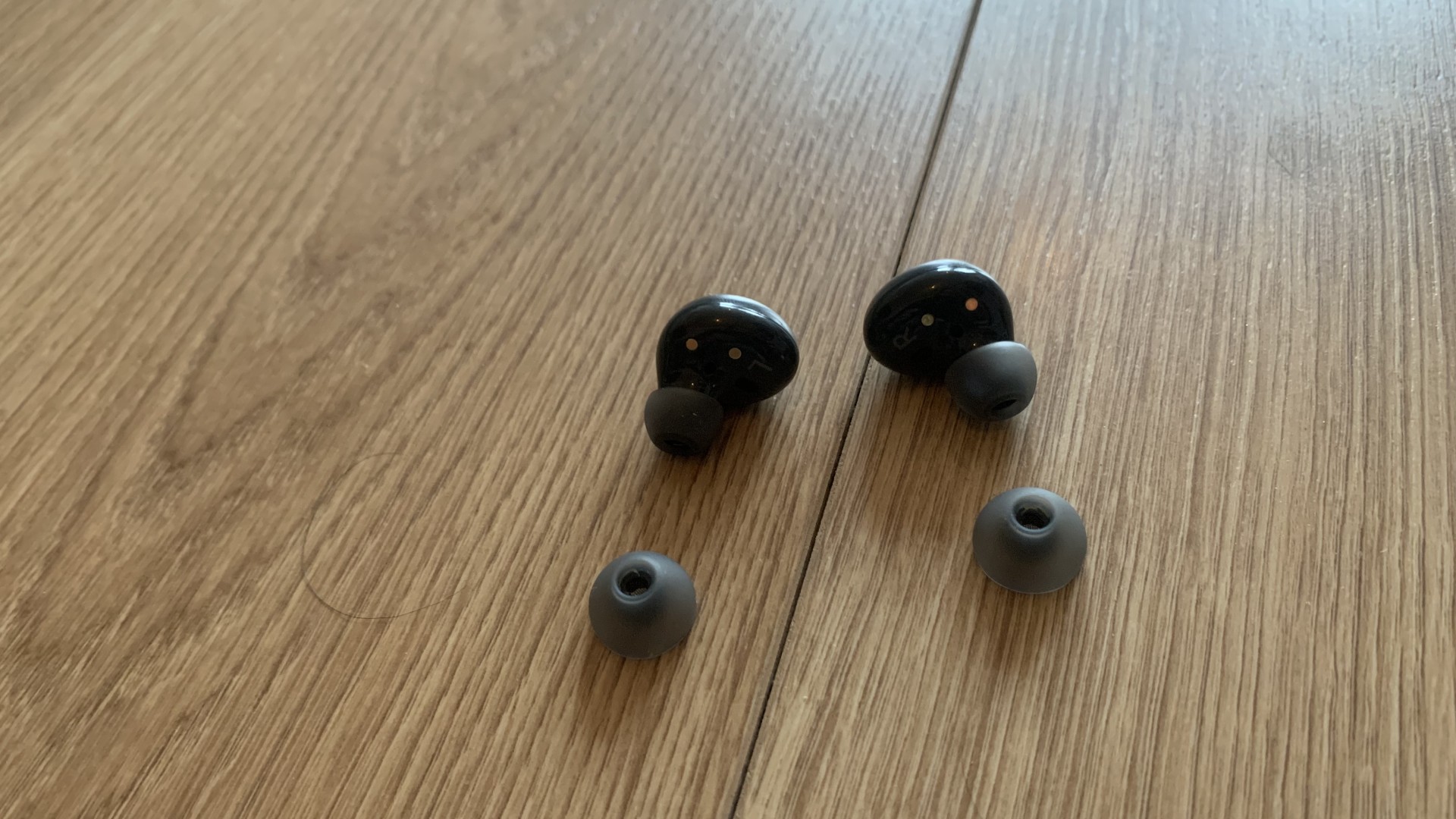
The Samsung Galaxy Buds2 offer a faultless Bluetooth connection for Android and iPhone users, and they sit very securely in your ears — we barely needed to adjust them during testing.
Samsung has designed the buds to connect with other Samsung wearables and work with their partner app — the Samsung Galaxy Wearable app — giving you full autonomy over earbud controls and allowing you to personalize your sound using various settings.
Tech-backed 360 sound ups the audio quality tenfold, regardless of what device you connect to, but the app is only available for Android and Galaxy users with this model. iPhone users can still connect via Bluetooth and use basic touch controls by tapping the buds to pause, stop, and play. But the app allows Android users to do more like set notifications, integrate Spotify, use equalizer settings, and access features like ‘find my earbuds.’
ANC (noise-cancellation) settings are also available in-app, and two outer and one inner mic detect ambient noise to improve sound quality and block out external noise, creating a truly immersive music experience.
We paired these buds with our iPhone, which meant our experience was limited, but the sound quality continues to be brilliant. Outdoors, we had to max out the volume to reduce traffic noise, but being able to tap the earbud to start and stop music was handy when running. Although, we accidentally activated them a few times when adjusting the fit.
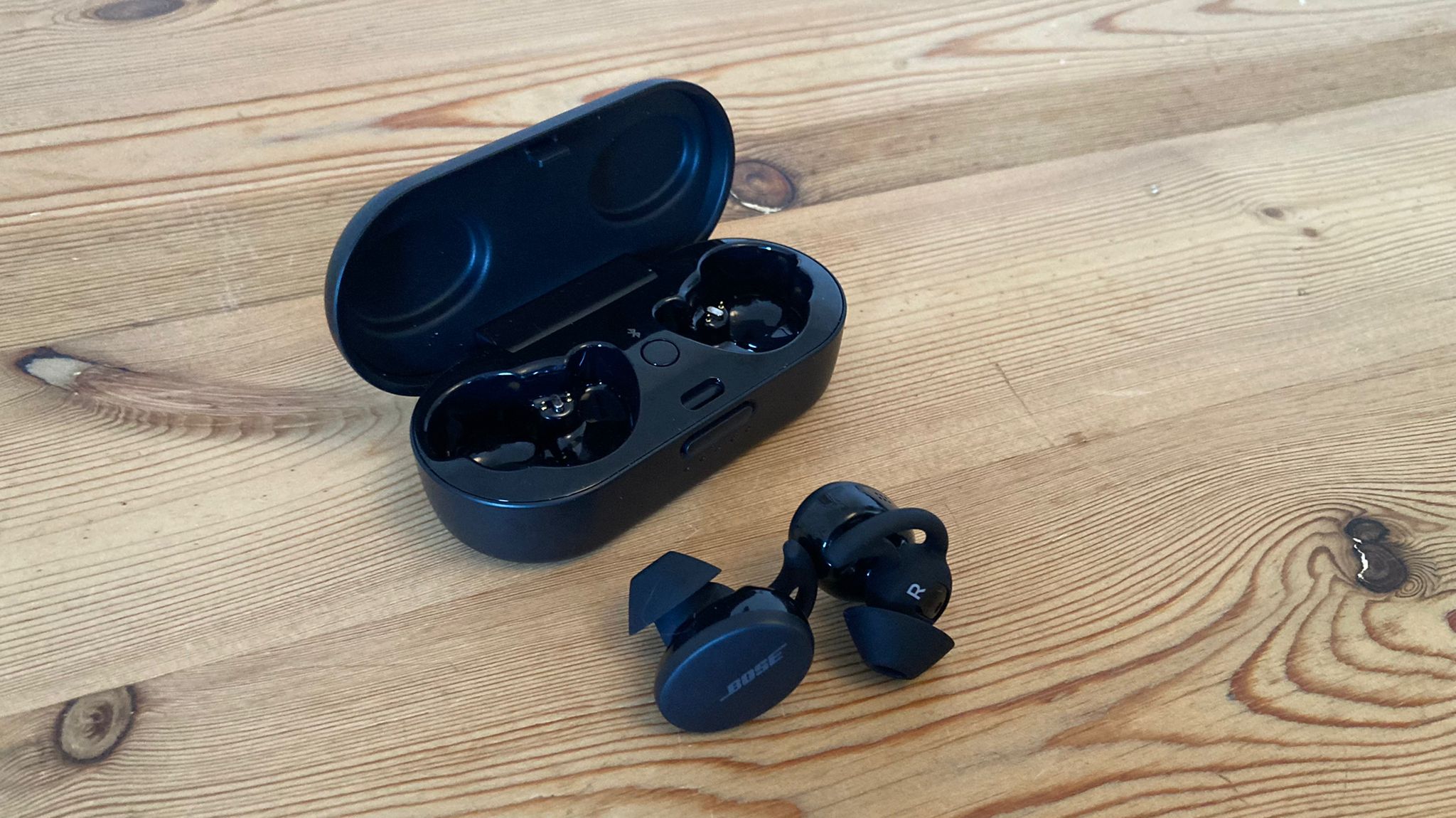
You don’t need to be an acoustics expert to know the difference between budget headphones and a quality pair. When you pop the Bose Sports in your ears and press play, you know you’re dealing with the latter.
The sound is rich and smooth, with balance and detail that will do your music justice — whatever the genre. We also found they sounded great with podcasts and videos, so if you’re after a set of headphones for running routes and commutes alike, the Bose Sports are more than up to the task.
They offer a fantastic fit too thanks to their unique “StayHear Max” silicone tips and wings. After placing these in our ears and twisting them backwards slightly to lock them into place, we found they were unmoving during longer runs and even a quick interval session. What’s more, because the silicone is softer and more forgiving than other models like the JBL Reflect Flow Pro, our ears never ached and we almost forgot we were wearing them.
The Bose Sport’s touch controls are more comprehensive than their competitors too. There are no single tap commands, minimizing the risk of an accidental press, while double taps, holds and swipes can pause, play, skip tracks and alter the volume. You can also set a shortcut on the left earbud to automatically open and play Spotify, which we liked as it minimized pre-workout distractions.
The frames are slightly bulkier than most, protruding from the ear slightly, and they (along with the case) have a plastic finish that makes them feel slightly less premium than the likes of the Mifo O5s or Adidas FWD 02s. There is also no ANC, which is a shame.
But don’t let this take away from their overall performance. If there was a venn diagram representing music lovers and sports fans, these headphones’ reliable fit, comfort and warm sound would make a great investment for anyone in the midsection.
- These earbuds are currently being tested. When we’ve finished with our testing, we’ll publish a full review to go alongside this guide.
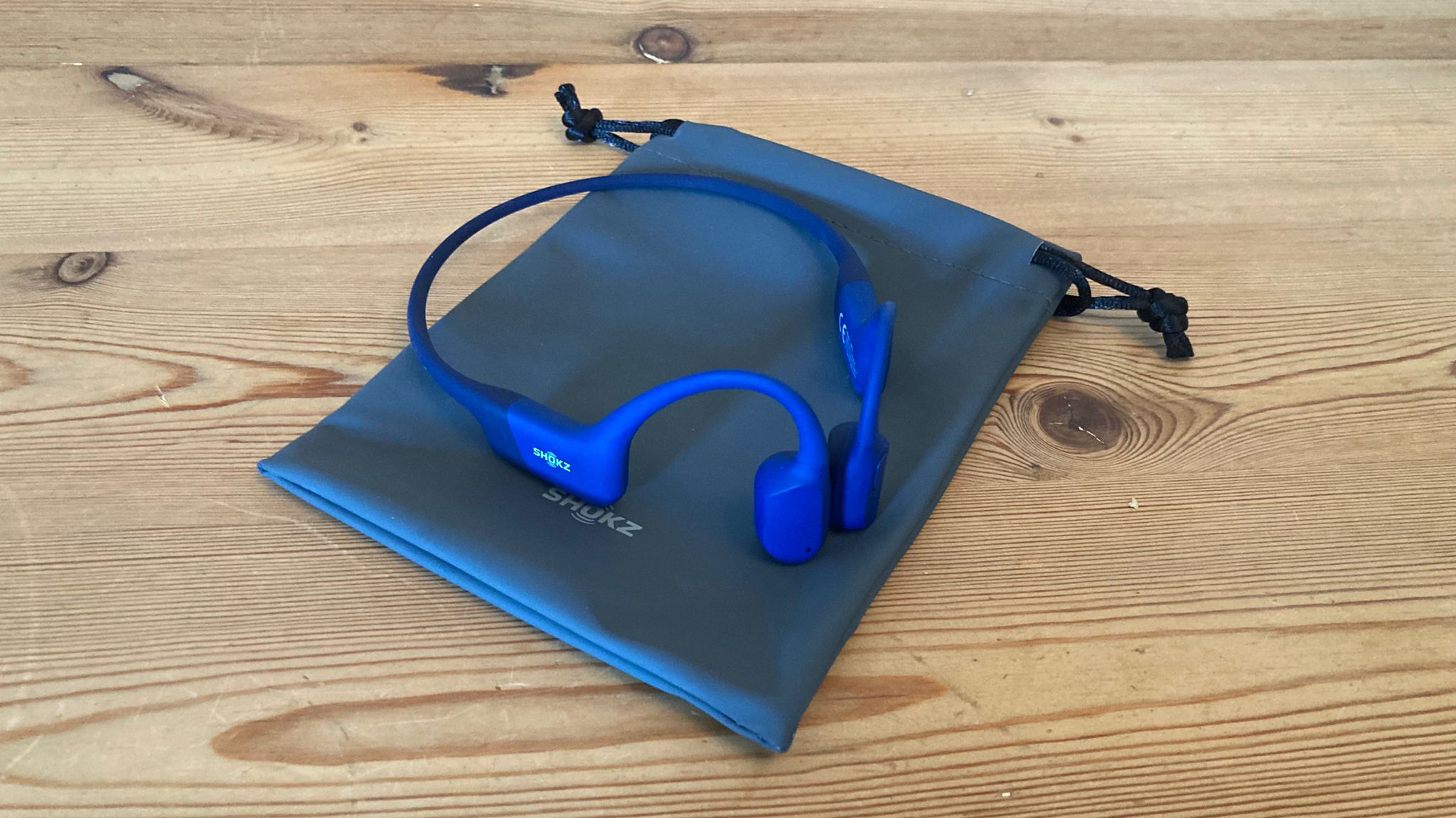
And now for something completely different. The Shokz OpenRun headphones, formerly known as the Aftershokz Aeropex, don’t go in your ear at all. Instead, they sit in front of the ear and use bone conduction technology to transmit sound to your inner ear via vibrations in your cheekbones.
If you’re new to this phenomenon, it might take a second to get used to, but the open-ear design has many benefits. If you tend to run on roads or in busy city environments, Shokz promises these headphones will allow for “total awareness of your surroundings” so you can rack up the miles in safety. They’re also great if you run with a buddy, as you can talk without pausing your music.
However, the open-ear design does mean they can’t offer ANC or sound isolation, meaning they’re not great for anyone wanting to drown out their gym’s outdated radio. Instead, these should be reserved for outdoor pursuits like running, hiking and cycling.
They do offer an impressive sound that might surprise those new to bone conduction technology though, and can pack a punch when you crank up the volume. We still found the OpenRuns didn’t have the same power or clarity as in-ear buds, but if you don’t like the feeling of in-ear silicone buds then Shokz should be your first port of call.
- These headphones are currently being tested. When we’ve finished with our testing, we’ll publish a full review to go alongside this guide.
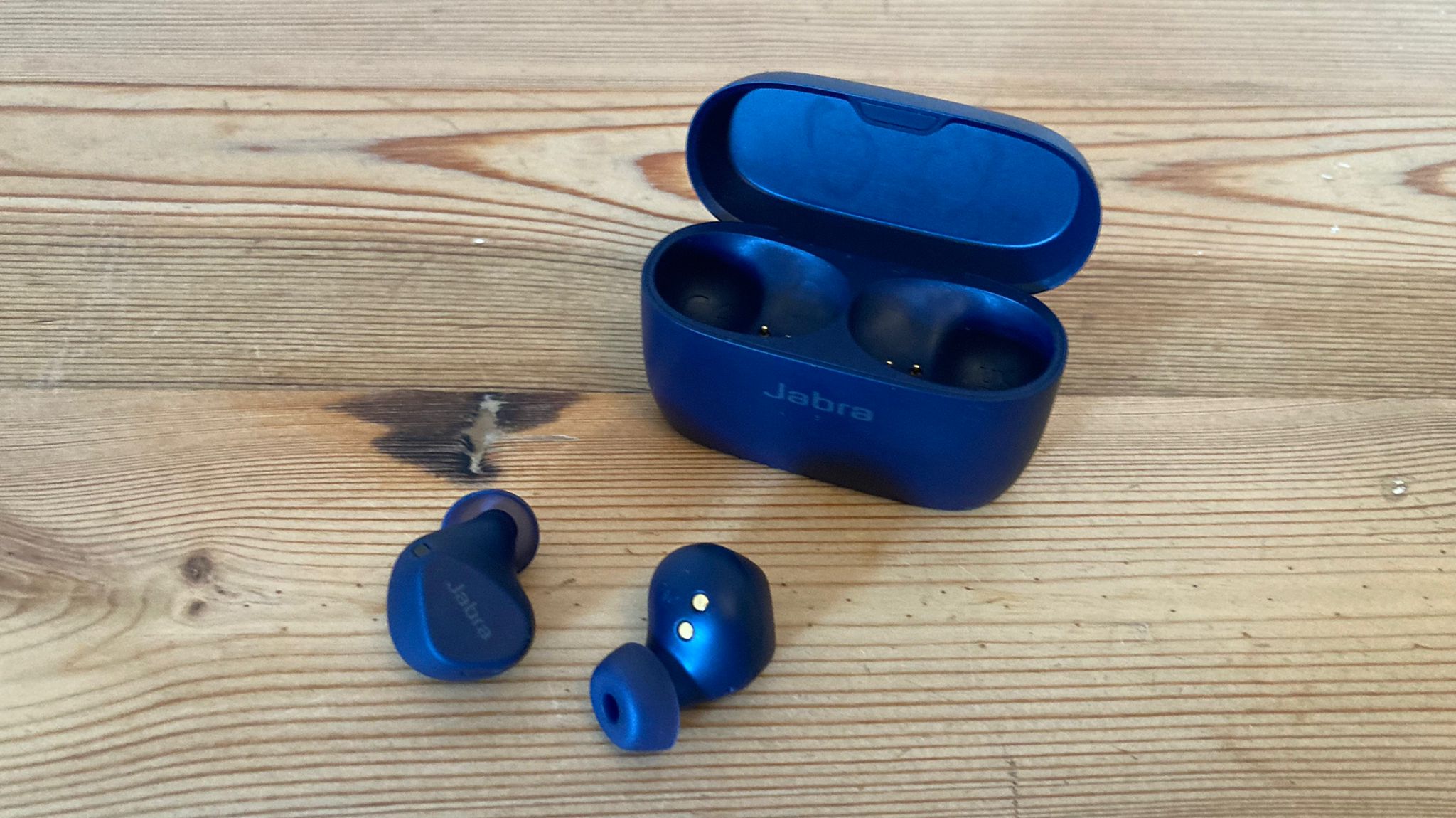
As the old adage goes: If it ain’t broke, don’t fix it. The Jabra Elite 4 Active earbuds take this tack, steering clear of reinventing the wheel and instead offering a solid pair of sports headphones that deliver a stable, natural fit and impressive sound. What more could you want?
Instead of silicone wings or ear hooks, they instead opt for an ergonomic frame designed to move with you as you exercise. We were initially skeptical about this lack of security features, but lo and behold it did its job admirably. This is great news for anyone who doesn’t like the feeling of too much pressure on their ears or finds the area sensitive, providing a more natural feeling alternative to other mainstream sports earbuds.
This isn’t the only good news for your ears either; they also offer ANC, customizable equalizer and an immersive sound. The result? Our music has rarely sounded better, and we could really feel the extra oomph of the audio as we took on testing topography.
If you want to take them off-piste and on to the trails, you don’t need to worry about dirt or splash damage either. They have IP57-rated water and sweatproofing, so perspiration and precipitation needn’t be a concern when wearing them.
They don’t have touch controls, with each earbud instead having a concealed button on the outside of its frame. However, we found these could be a bit fiddly to press, and required a fair bit of force so the earbuds could be pushed into our ear.
- These headphones are currently being tested. When we’ve finished with our testing, we’ll publish a full review to go alongside this guide.
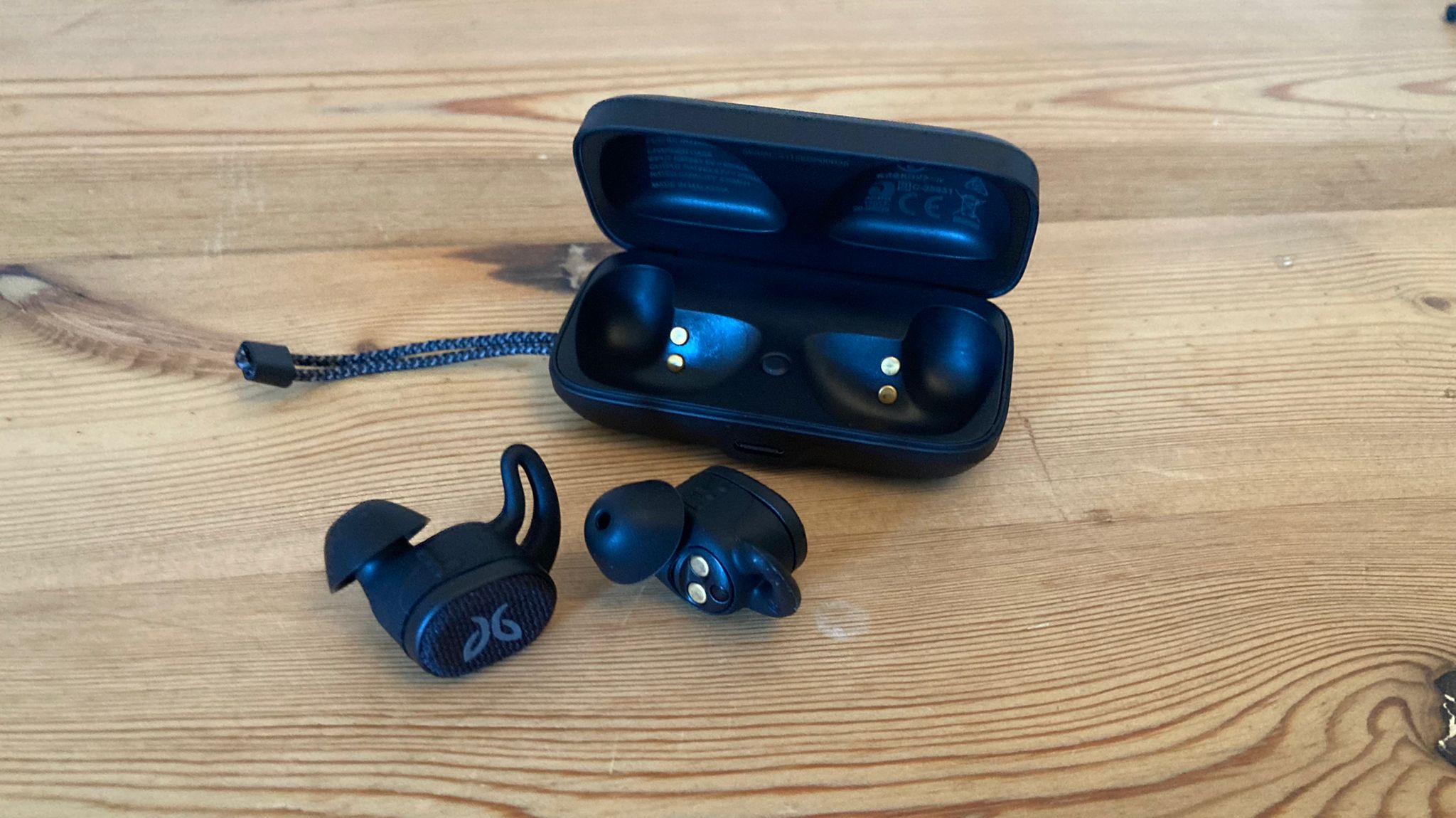
When it comes to building bulletproof tech, Jaybird weren’t messing around with the Vista 2. The earbuds have a robust IP68 rating, putting them at the upper limits of the dust and waterproofing scale. Even the sleek, compact charging case is IP54-rated or “weatherproof”, making it a great traveling companion for trail runners.
They have four mics and are made with “WindDefense” fabric on the frame, so strong gusts won’t hamper your listening even if you’re running along the coast or summiting mountainous terrain. And, if you have a long run on the horizon, the eight-hour battery life should ensure you’re entertained throughout. A five-minute top-up in the case will also give you an extra hour of playback, which is a feature we really liked.
The Jaybird Vista 2s shouldn’t just be commended for their durability credentials though. We found the sound was powerful yet pleasingly detailed, particularly when we played with the EQ settings in the Jaybird app to find our ideal balance. The app will also give you the option to customize the button controls (each earbud has a button built into the frame) and choose between semi-effective ANC or SurroundSense — a set-up that allows some external noise in.
Overall, we found these headphones can handle most environments and offer great sound throughout. As a result, they would make a worthy addition to the ears of any trail runner, hardy hiker or adventurous exerciser.
- These headphones are currently being tested. When we’ve finished with our testing, we’ll publish a full review to go alongside this guide.
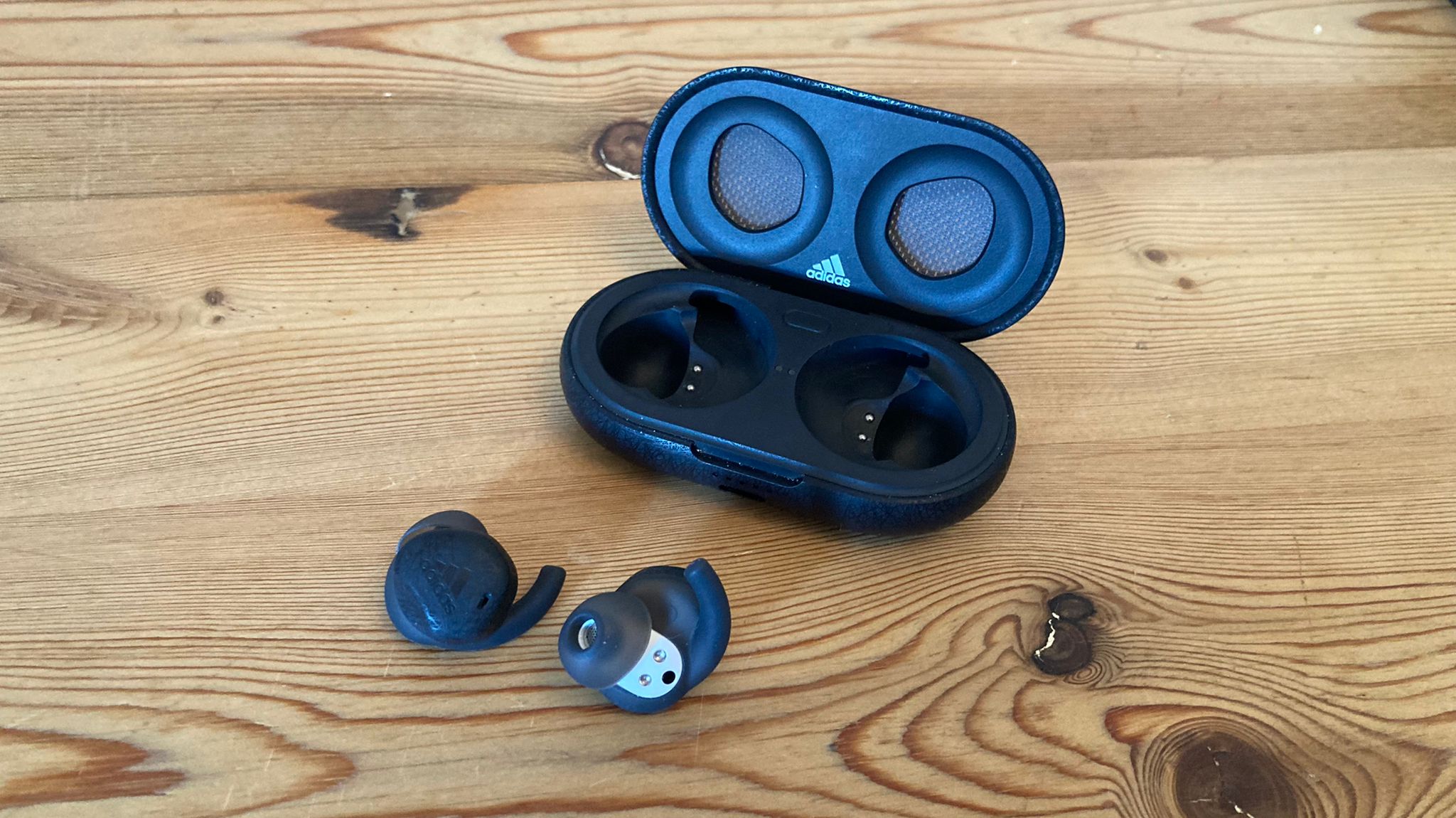
Among the likes of audio royalty such as Bose and Beats, Adidas may be a surprising name to see in this list. But don’t overlook these excellent earbuds, they’re designed from the ground-up to be optimized for running, and we think the brand has nailed its brief.
Nowhere is this more evident than the fit. Of all the headphones we tested, these were by far the most comfortable, and placing them into our ears felt as natural as slipping on a sock. They didn’t let us down during runs and other exercise sessions either, with a choice of four silicone tips and four wings so you can find the right size for you via trial and error. Once we’d found a combination that worked, we found these headphones didn’t come dislodged — whether we were out on a fast 5K or hitting handstand push-ups in a CrossFit box.
The sound is powerful, with a booming bass that lends itself well to electronic music. There is no ANC, and those who prefer working out to softer genres may want a more cleaner sound, but you can play with the EQ settings in the Adidas Headphones app to nullify this somewhat.
The earbuds themselves feel robust, with a premium rubberised finish, and the charging case looks cool at first with its fabric lid. After using them though, we would’ve preferred a sturdier case to inspire confidence when we popped them loose into our kit bag.
- These headphones are currently being tested. When we’ve finished with our testing, we’ll publish a full review to go alongside this guide.
How we test the best running headphones
To make sure that each set of headphones gets a proper review, we wore them for series of sprint interval sessions and longer, moderately-paced runs, while also donning them for a range of other exercise methods including gym visits, functional fitness sessions and yoga.
We also listened to a wide variety of music — from folk to pop to rock to EDM — to ensure the headphones can deliver sterling sound quality regardless of genre.
After testing, the headphones are scored on their design, fit, sound quality and value for money. These results are used to calculate a final verdict, out of five.
Are headphones good for running?
To answer this question, it’s important to first ask another question: Which headphones are you using?
You see, regular headphones are made for everyday wear, but they may be unsuitable for sport due to a lack of dust resistance or waterproofing which can see them come unstuck when you break a sweat, venture out in the rain or take your training off the beaten track. Other features that can let headphones down when running are insufficient battery life and an insecure fit. After all, no one wants to be left to suffer in silence, or lose valuable seconds searching for a stray earbud in the undergrowth during their jog.
However, nowadays there are a wide selection of headphones designed specifically for sport. To set them apart from your average earbud, they will be designed to maintain their sound quality while on the move, withstand sweat, rain and other adverse weather conditions, and stay in your ear no matter how intense your session gets.
To ensure that final point, they’ll usually have ear hooks or silicone fins (that sit outside or inside the ear, respectively).
So, yes, headphones are good for running — if you buy the right ones. Read our reviews above to find out which pairs offer the fit, resilience and winning sound you need.
Is it good to listen to music while running?
There have been a fair few studies into the impact certain soundtracks can have on running performance over the years. And, among the most recent ones, it appears to be good news for music fans.
One study, published in the Ergonomics (opens in new tab) journal, saw 30 volunteers perform a series of 10 minute exercise sessions on a treadmill. Each one was accompanied by either no music, or music of different tempos and volumes, with positive impacts on performance (running speed and heart rate) observed when subjects ran with music.
It concluded: “These results confirm that fast, loud music might be played to enhance optimal exercising.”
So, whatever your usual musical tipple, science says your favorite tunes can make for great running companions.
A second 2020 study published in the Sports Basel (opens in new tab) journal reinforces this message. It looked to observe the impact of preferred music on running performance and pacing during a six minute run test. The results of the experiment showed that exercisers’ total distance covered increased when they ran to their chosen tracks, and their blood lactate concentration actually decreased.
In other words: stop shying away from your guilty pleasure playlist, it could be your secret weapon as you push for a new PB.
This article is for informational purposes only and is not meant to offer medical advice.





